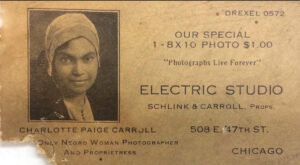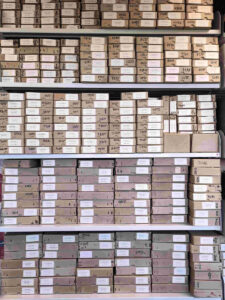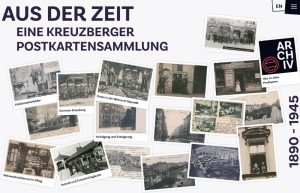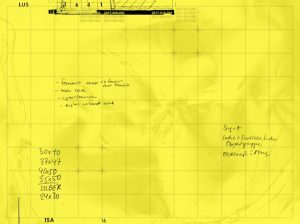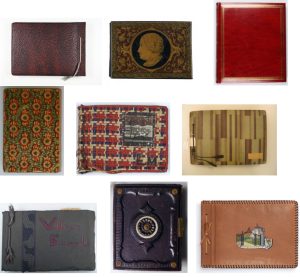Putting Images to Work: Constructing, Complicating and Subverting Gender As cultural products, images are infused with notions of gender – notions, which are, of course, specific to the times and places in which these images originate. For gender historians, they are fascinating artefacts, but often also frustratingly difficult to interpret. This dossier presents the […]
Theme Dossier: Putting Images to Work – Gender and the Visual Archive
The thematic dossier “Putting Images to Work – Gender and the Visual Archive,” edited by Christina Benninhaus and Mary Jo Maynes, presents the work of historians who use visual sources to explore gender. This work was first discussed at the 2023 Berkshire Conference on the History of Women, Gender, and Sexuality. The authors draw […]
Grüße aus dem „Stammlokal der Spießbürger“
Anlass und Gegenstand dieses Aufsatzes ist eine außergewöhnliche „Sammlung in der Sammlung“. Im Jahr 2022 wurde dem FHXB Friedrichshain-Kreuzberg Museum in Berlin ein Nachlass übergeben: das Lebenswerk des Privatsammlers Peter Plewka (1938-2022), der über 5600 historische Ansichtskarten seines Heimatbezirks Kreuzberg zusammentrug.
Quelle: https://visual-history.de/2025/09/08/koenig-schenk-gruesse-aus-dem-stammlokal-der-spiessbuerger/
Visual Analytics für Bilder aus kolonialen Kontexten (VABiKo) / Image archive on former German colonies to be made accessible with Artificial Intelligence
Das zentrale historische Bildarchiv der deutschen kolonialen und kolonialrevisionistischen Bewegungen ist einer der größten fotografischen Bestände dieser Art und spielt eine wichtige Rolle in der Aufarbeitung der deutschen Kolonialgeschichte. Dieses Bildarchiv wird jetzt durch automatisierte Bildanalyseverfahren und Deep-Learning-Methoden in einem öffentlichen Internetportal zugänglich gemacht. Die Verortung in sowohl kolonialen als auch in NS-Kontexten erfordert eine […]
Quelle: https://visual-history.de/2025/06/09/visual-analytics-fuer-bilder-aus-kolonialen-kontexten/
Ausstellung: Jimmi Wing Ka Ho: Invisible City
Wie sichtbar ist die koloniale Vergangenheit einer Stadt? Dieser Frage widmet sich der Künstler Jimmi Wing Ka Ho in der Ausstellung Invisible City, einer fotografischen und filmischen Spurensuche in chinesischen Metropole Qingdao.
Quelle: https://visual-history.de/2025/06/05/ausstellung-jimmi-wing-ka-ho-invisible-city/
Ansichtskarten ausstellen
Im Rahmen unseres Praxisprojekts im Masterstudiengang Public History haben wir uns intensiv mit der Sammlung Peter Plewka auseinandergesetzt und auf Basis der über 5500 digitalisierten Ansichtskarten aus Berlin-Kreuzberg vor 1945 eine digitale Ausstellung kuratiert.
Ausstellung: Auf Augenhöhe – Afrika und seine Moderne Jean Molitor
In Burundi steht ein überdimensionales Schwammerl. Ein Foto davon ist derzeit im Berliner Willy-Brandt-Haus zu sehen, gemeinsam mit anderen Aufnahmen verschiedener Gebäude der Moderne in afrikanischen Staaten – sie sind Teil der aktuellen Ausstellung „Auf Augenhöhe – Afrika und seine Moderne“ mit Fotografien von Jean Molitor. Die Aufnahmen sind allerdings nicht nur für Liebhaber:innen steingewordener […]
Frame by Frame
Das Symposium versteht sich als Diskussionsforum aktueller Diskurse der Sammlungsarbeit an der Schnittstelle von Theorie und Praxis.
Quelle: https://visual-history.de/2024/04/19/frame-by-frame/
Provenienzforschung und Fotografie
Fotografien sind wichtige Quellen, um NS-Raubgut in historischen Wohnräumen zu identifizieren oder Sammlungsgut aus kolonialen Kontexten zuzuordnen – sie können aber auch selbst Gegenstand von Raub und Entzug sein.
Quelle: https://visual-history.de/2024/03/28/provenienzforschung-und-fotografie/
Fotoalben im Jüdischen Museum Berlin
Ein Schwerpunkt der Sammlung des Jüdischen Museums Berlin sind sogenannte Familienkonvolute, die starke biografische Bezüge aufweisen und dem Museum von Stifterinnen und Stiftern aus der ganzen Welt geschenkt wurden.
Quelle: https://visual-history.de/2024/02/14/unsichtbar-ziehe-fotoalben-im-juedischen-museum-berlin/

